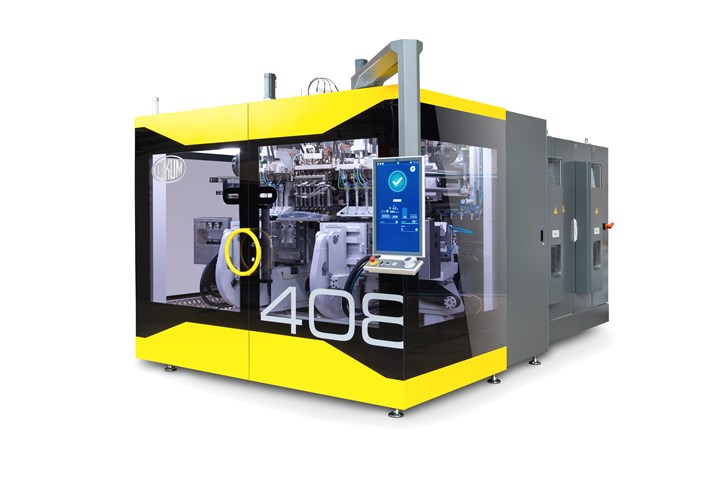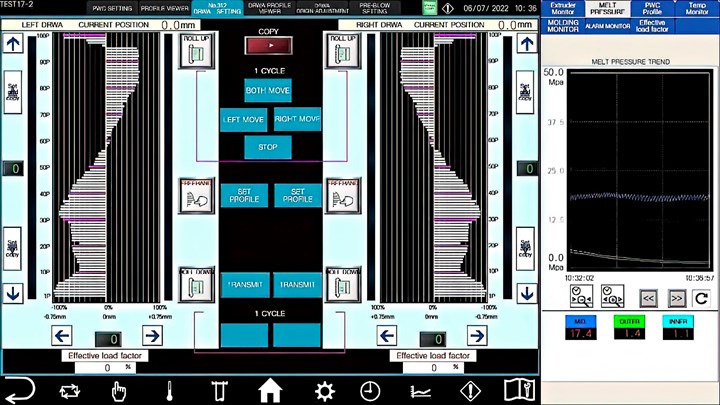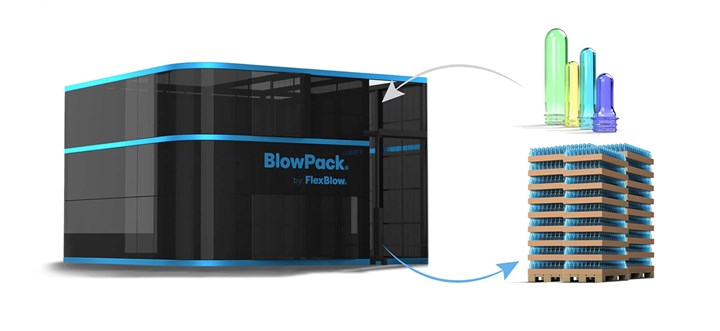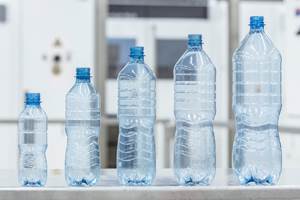How Was K 2022 for Blow Molding?
Over a dozen companies emphasized sustainability with use of foam and recycle, lightweighting and energy savings, along with new capabilities in controls, automation and quick changeovers.

Bekum’s EBlow 408D, one of its new 8-series all-electric shuttles, exemplified several themes of K 2022: energy efficiency (up to the highest Class 10 under Euromap 46.1); new “Industry 4.0-capable” controls, providing continuous AI quality monitoring, energy-consumption display and web connectivity; and quick mold changes in 15 min per side. (Photo: Bekum)
October’s K 2022 show in Düsseldorf hosted around two dozen blow molding-related machinery exhibits, focused primarily around the show’s banner themes of sustainability and digitalization. In the spirit of full disclosure, I did not attend the show myself (first K I’ve missed since my first in 1979), but I have gathered what I could from 18 suppliers of blow molding technology, most of which has been reported piecemeal in Plastics Technology since last July. Here is my first opportunity to pull everything together for an overview of the news.

Recycling via blow molding was highlighted by many exhibitors. Kautex showed off child-size watering cans blown from recycled PE fishing nets on a continuous-extrusion machine. (Photo: Kautex)
Sustainability in the Spotlight
The most common note struck by blow molding (and other molding) exhibits at K was recycling (aka the “circular economy”). For example, Kautex produced child-sized watering cans from recycled PE fishnets on a continuous-extrusion shuttle (testimony to the consistency of the pellet compound from Braskem). And KHS showed off a 2.3-liter bottle with a glued-in handle, both of 100% rPET. The company says this new design provides 10% material savings over PET bottles with clip-in handles. (See below for more source-reduction themed exhibits).
Bekum celebrated the circular economy by molding bottles from a compound containing 50% recycled HDPE on its new 8-series extrusion blow machine (more on this below). And Aoki touted the ability of its Aoki Series injection stretch-blow (ISBM) machines to handle rPET flake directly from reground and washed bottles without repelletizing.
Other people showed off their multilayer extrusion heads that allow for burying PCR in the center of a container (among other uses) — namely W. Müller, Uniloy (on its new UCS10.ED shuttle), Plastiblow on its new PB50ES-1000 Coex3 machine (more below), and ST BlowMoulding (on its new AX 880 accumulator-head model). Nissei ASB showed off its new ASB-12M-21NJ ISBM machine with twin injectors, which could mold a thin inner layer of virgin (30% of total wall thickness) and an outer layer of rPET flake. The same company exhibited an HSB Series double-blow heat-set reheat ISBM machine to make a 1 L returnable/refillable PET bottle that not only weighs 14.5% less than the current industry standard but meets refillable bottle standards using up to 30% rPET.
Opportunities for using PCR together with lightweighting were highlighted by Trexel, which has launched a new thrust into blow molded packaging for its MuCell microcellular foaming process. Trexel showed off an opaque white PET bottle for light-sensitive products like milk; opacity is provided by a MuCell foamed layer without need for pigment. The bottle was produced in cooperation with Husky, whose three-layer co-injection process was used to mold preforms with a foamed center layer.
Nissei ASB also struck the note of source reduction in exhibits of two novel thin-walled collapsible containers of stretch-blown PET. One was a 12 L bag-in-box style container for home water dispensers; it weighs only 120 g. It was molded on a newly developed PF36/9-12000 1.5-stage ISBM machine. The second entry was an airless pump spray bottle with a thin inner layer of PP that easily delaminates from the PET outer wall and collapses as the contents are dispensed. The collapsible PP layer weighs only 5.7 g but still adds greater moisture barrier to the PET bottle.

Many equipment exhibits focused on energy efficiency, such as the new heating/cooling system from W. Müller, with aluminum heating strips instead of ceramic heaters. It’s shown here in a RECO3 system for three-layer coextrusion with a PCR core. (Photo: W. Mueller)
Save Energy, Save the Planet
Another contributor to the K show’s sustainability theme was energy savings. More efficient machine designs were presented by Bekum with its new EBlow 8 series for packaging and XBlow hybrid industrial machines (named for their diagonal tiebars — details here); ST Blowmoulding with its AX 880 accumulator-head machine with new electric clamp; Uniloy’s new all-electric UCS10.ED small shuttle; Magic’s new all-electric ME series extrusion blow molders, newly commercial all-electric MTM-170 one-stage ISBM machine, and electrically driven accumulator head (patent applied for); Plastiblow’s new PB50ES-1000 with 55-ton clamp, largest in its all-electric shuttle series (represented here by Globeius, more details here); Tahara’s new all-electric TJS shuttles; Jomar’s newly beefed-up 85-S Gen II injection-blow molder; 1Blow’s latest “GreenBlow” PET reheat stretch-blow machine with very low power and air consumption (details here); Wilmington Machinery’s new Series IV high-volume wheel for calibrated bottles; and W. Müller’s energy-saving barrel-heating/cooling system using air cooling and aluminum heating tapes instead of ceramic heaters.
Both Bekum and ST BlowMoulding said their new machines can meet the highest category of specific energy efficiency — Class 10 under Euromap 46.1, or less than 0.29 kWh/kg of resin processed.

Improved control capabilities were exemplified by the new DRWA electronic parison wall-thickness concentricity adjustment, operated from the control panel on Tahara’s new all-electric TJS shuttles. (Photo: Tahara)
Greater Processing Efficiency, Too
The other major theme of the show was “digitalization,” or the trend to smart manufacturing through software and communications technologies. Magic, for example, introduced an electrically driven system for changing head center distances from the operator panel (patent applied for) on its new ME-series electric shuttles, as well as new Self Adjustment technology that makes eight different auto adjustments. Tahara debuted the DRWA (Die Radial Wall-Thickness Adjustor), offered in collaboration with JSW — its parent company — for its new TJS line of electric shuttles. Agr International brought out Process Pilot+ for automatic adjustment of PET ISBM machines based on bottle wall-thickness measurements. The new version reportedly corrects process drift as much as 40% faster than before and enables startups to reach on-spec bottle production up to 65% faster. (Agr also introduced a dual-mode portable thickness gauge for packaging.) Bekum’s new 8.0 controller for its latest machine series includes artificial intelligence (AI) for continuous product-quality monitoring and can visualize energy consumption on the operator panel. And Wilmington has upgraded controls on its new Series IV wheel machine that provide for data collection and trending analysis. In addition, several machine suppliers highlighted their machines as “Industry 4.0-ready,” including internet connectivity for remote monitoring and support.

Among the exhibits of blow molding automation was the new BlowPack from FlexBlow, described as the “world’s first” integrated combination of PET bottle blowing, leak testing and palletizing in one ultra-compact machine. (Photo: Flexblow)
Closely allied with improved controls were advances in blow molding automation at K 2022. Magic’s new Magic Robotica subsidiary showed off a robot arm palletizing PET bottles coming off its new MTM 170 ISBM machine, as well as a standalone robot with vision system that can pick different shapes or colors of bottles from a single belt conveyor and place them on different pallets. Meanwhile, FlexBlow (UAB Terekas) introduced the patented BlowPack system described as “the world’s first” integrated combination of PET bottle blowing, leak testing and palletizing in one ultra-compact machine.
Besides automation, one of the greatest enhancements to productivity comes from quick tooling changeover. ST BlowMoulding introduced Automatic Head tooling Changeover (AHC), activated by the operator entirely from the control panel. Bekum’s new small 8-series shuttles are equipped with quick-release levers on the rear clamp platen and can be furnished with a double-sided mechanical quick-change system from another supplier. Bekum’s new larger 8-series machines have molds mounted with mechanical couplings and allow for mold changes in 15 min per side. And Magic’s new ME-series has a new quick-change system that reportedly allows a complete format changeover of molds (with magnetic mounting), blow pins and center distances in just 45 min.
Related Content
For Extrusion and Injection-Blow Molders, Numerous Upgrades in Machines and Services
Uniloy is revising its machinery lines across the board and strengthening after-sales services in tooling maintenance, spare parts and tech service.
Read MoreFirst Water Bottles With Ultrathin Glass Coating
Long used for sensitive juices and carbonated soft drinks, KHS Freshsafe PET Plasmax vapor-deposited glass coating is now providing freshness and flavor protection for PET mineral water bottles.
Read MoreBreaking News From NPE2024
Here is a firsthand report of news in injection molding, extrusion, blow molding and recycling not previously covered.
Read MoreRead Next
Modified Machines to Mold Unusual PET & PP Bottles at K 2022
K 2022 visitors looking for new ideas in stretch-blown containers will be treated to two novel collapsible concepts a the Nissei ASB booth.
Read MoreAt K 2022: Improved Automatic Process Control for PET Bottle Blowing
New Process Pilot+ from Agr International offers faster response and flexible goals for keeping PET bottles on spec.
Read More



















